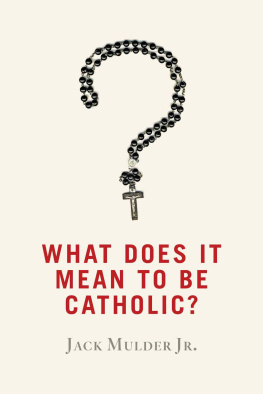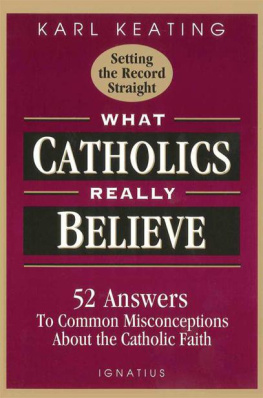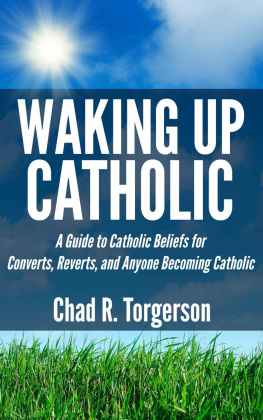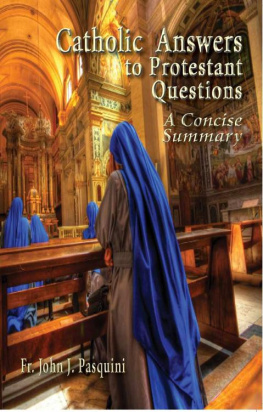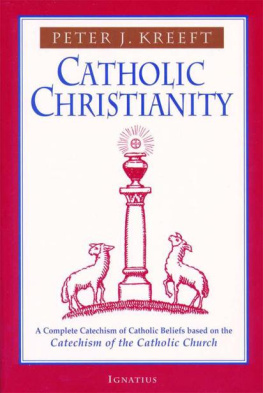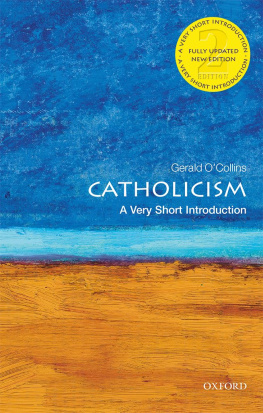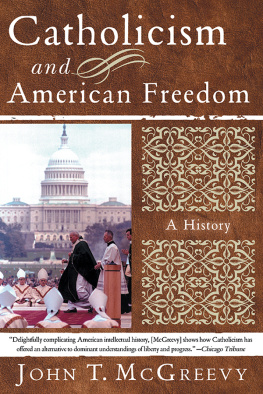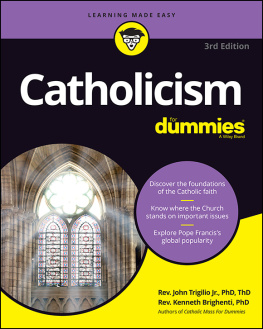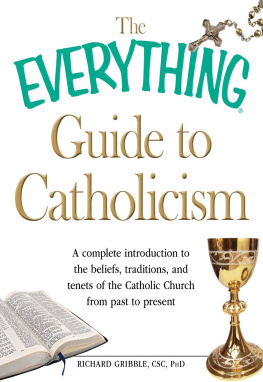What Does It Mean to Be Catholic?
Jack Mulder Jr.
William B. Eerdmans Publishing Company
Grand Rapids, Michigan / Cambridge, U.K.
Nihil obstat:Rev. Charles R. Dautremont, S.T.L.
Censor Deputatus
April 8, 2014
Imprimatur:Most Rev. David J. Walkowiak, J.C.D.
Bishop of Grand Rapids
April 25, 2014
Note: The nihil obstat and imprimatur are official declarations that a book or pamphlet is free of doctrinal or moral error. No implication is contained therein that those who have granted the nihil obstat and imprimatur agree with the content, opinions, or statements expressed.
2015 Jack Mulder Jr.
All rights reserved
Published 2015 by
Wm. B. Eerdmans Publishing Co.
2140 Oak Industrial Drive N.E., Grand Rapids, Michigan 49505 /
P.O. Box 163, Cambridge CB3 9PU U.K.
www.eerdmans.com
Printed in the United States of America
Library of Congress Cataloging-in-Publication Data
Mulder, Jack, author.
What does it mean to be Catholic?: a guide for the curious / Jack Mulder Jr.
pages cm
ISBN 978-0-8028-7266-1 (pbk.: alk. paper)
eISBN 978-1-4674-4402-6 (ePub)
eISBN 978-1-4674-4362-3 (Kindle)
1. Catholic Church Doctrines. I. Title.
BX1754.M74 2015
282 dc23
2015004726
Scripture texts in this work are taken from the New American Bible, revised edition 2010, 1991, 1986, 1970 Confraternity of Christian Doctrine, Washington, D.C., and are used by permission of the copyright owner. All Rights Reserved. No part of the New American Bible may be reproduced in any form without permission in writing from the copyright owner.
For our children, Maria and Lucas,
our godchildren,
and the students of Hope College,
that they may grow in grace and in the knowledge
of our Lord and Savior Jesus Christ (2 Pet. 3:18).
Contents
Acknowledgments
The work in this book, it will be quickly discovered, is very meaningful to me personally. Perhaps some people find it important to write without invoking their own lives, but I just dont. I hope that isnt self-indulgent. I simply find it helpful to approach topics as someone who cares about the answer. When I joined the Catholic Church ten years ago, I would have found something like this book to be helpful, and that is why I wrote it. It is not intended as an encyclopedia of Catholicism, but it is intended to give some help on what the Catholic Church has taught through the years. If adult Catholics have an experience like mine, they are unlikely to learn anything like the full spectrum of Catholic teaching before they actually become Catholic. Because of this, few non-Catholics will get an accurate representation of Catholic beliefs. So I thought it might be good to explain some important beliefs in a way that I thought could be approached by people who might be curious. The result, with a generous helping of grace, is the modest book youre reading.
I like to say I didnt really receive a catechesis, but this isnt true. My best teachers were my parents, who taught me the Christian faith and nurtured in me a love of Jesus. I still remember my dads high-school Sunday school class on the Heidelberg Catechism. Without this, the best kind of catechesis, I could not have learned how to follow the same Lord Jesus into a new tradition, that of the Catholic Church. I also learned a great deal from my wife, Melissa, and her family. Some of the best teaching of the Catholic faith happens through the Mass, and so many faithful Catholics know their faith through prayer and worship before they ever bother to articulate it to themselves and others. I have learned a lot this way, and continue to do so.
Another way I learned the Catholic faith is by being challenged to explain it, both to myself, which I had to do anyway as a theologically inclined philosopher, and to others. This has happened in countless conversations since I became Catholic, but it has particularly been true of my time teaching at Hope College. Hope is a wonderful place and it has been truly providential in my life. Since I returned to teach at Hope, many of my colleagues and students have been both gracious and inquisitive, and it has pushed me to investigate more deeply and articulate my Catholic faith more clearly. For this I am truly grateful. It is not always easy to explain how the Catholic faith is distinctive when distinctiveness is sometimes felt to tear at the unity we so deeply desire. My hope is that we can continue to inquire together in ways that show concern for one another and for the truth. My colleagues in philosophy (especially Carol Simon, now of Whitworth University) have been extremely helpful in this process, as have other friends around campus. In particular, two students who helped me develop this book were extraordinary dialogue partners, namely, Andrew Peterson and Chikara Saito. Without their work the book is almost unimaginable. It has also been enjoyable, and invigorating, to talk with Catholic friends who share a commitment to exploring the teachings of the faith, and to seeking truth together, especially Louis Mancha, Joe LaPorte, Lyra Pitstick, and Jared Ortiz. I also wish to thank Fr. Charlie Brown and Msgr. William Duncan for helping me obtain an imprimatur for this work, and His Excellency Bishop David Walkowiak for granting it. Thanks also to the helpful people at Eerdmans, especially William B. Eerdmans Jr., Linda Bieze, and Mary Hietbrink.
I pray this little book will help the reader come to know and love Jesus more.
Abbreviations and Frequently Cited Works
LW Luthers Works. Ed. Jaroslav Pelikan and Helmut Lehmann. St. Louis: Concordia, 1955-1986. Cited by volume and page number.
DHHeinrich Denzinger and Peter Hnermann. Enchiridion Symbolorum, definitionum et declarationum de rebus fidei et morum. 43rd edition. Ed. for English edition by Robert Fastiggi and Anne Englund Nash (San Francisco: Ignatius Press, 2012). Cited by paragraph number.
CCC Catechism of the Catholic Church. 2nd edition. Washington, DC: United States Catholic Conference, 1994. Cited by paragraph number. See http://www.vatican.va/archive/ccc/index.htm .
ST St. Thomas Aquinas. Summa Theologica. 5 vols. Translated by the Fathers of the English Dominican Province. 1948, repr. Allen, TX: Christian Classics, 1981. Cited by part, question, and article.
CCL Code of Canon Law. Vatican: Libreria Editrice Vaticana, 1983. Cited by canon number. See http://www.vatican.va/archive/ENG1104/_INDEX.HTM .
For Vatican documents appearing after 1950 or otherwise not included in available editions or translations of Denzinger, refer to the following URLs:
Papal documents:
http://www.vatican.va/holy_father/index.htm
Documents from the International Theological Commission
(unless another source is given):
http://www.vatican.va/roman_curia/congregations/cfaith/cti_index.htm
Documents from the Congregation for the Doctrine of Faith:
http://www.vatican.va/roman_curia/congregations/cfaith/doc_doc_index.htm
Documents from Vatican II:
http://www.vatican.va/archive/hist_councils/ii_vatican_council/index.htm
Documents from the Pontifical Council for Promoting
Christian Unity:
http://www.vatican.va/roman_curia/pontifical_councils/chrstuni/index.htm
Compendium of the Social Doctrine of the Church:
http://www.vatican.va/roman_curia/pontifical_councils/justpeace/documents/rc_pc_justpeace_doc_20060526_compendio-dott-soc_en.html
Introduction
As I write this sentence, I am sitting in a huge convention center having just met a man who told me he had never been around so many Catholics who cared so deeply about their faith. Neither had I. There can be little question that in recent years Catholics have not done a very good job of educating their own about the Catholic faith. Consequently, Catholics have not done a very good job of educating others about the Catholic faith. There are signs of encouragement. Recent popes, beginning with Pope Paul VI (pope from 1963 to 1978), called for a new period of evangelization of both those who have not heard the Gospel as well as those who have heard the Gospel but need to return to the faith with fresh eyes. This book is really for three groups, namely, new Catholics who want to know more about their faith; non-Catholics who want to understand Catholic distinctives better; and lifelong Catholics who would like to be reacquainted with what they believe. The purpose of this book is to describe and explain a Catholic worldview to a contemporary audience. My purpose is not to convert the reader, but I do want lay Catholics and especially other Christians to consider what a coherent Catholic faith could look like. I cannot attempt to explain everything, nor can anyone claim to know everything, but I am captivated with the Catholic faith, and I want to explain why. Other Christians will find me interacting with thinkers from lots of Christian traditions and showing how and why Catholic teaching differs from their views on various points. I hope that such Christians consult their own traditions first in an effort to think through how to love Jesus Christ with their minds, as he himself commands us (Luke 10:27).
Next page
